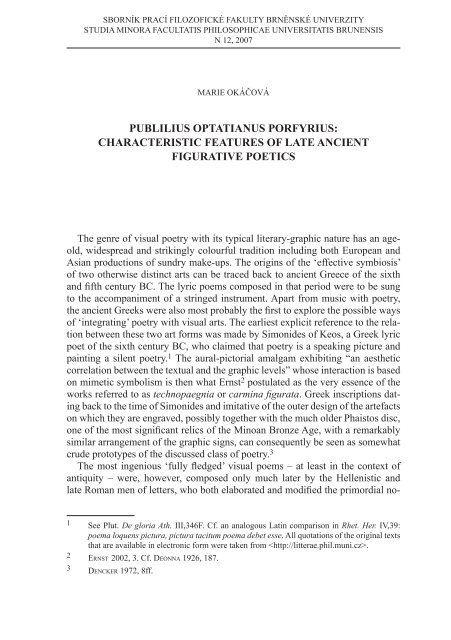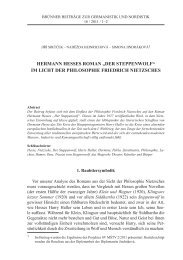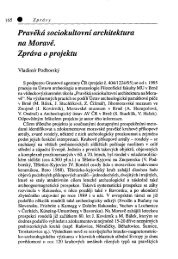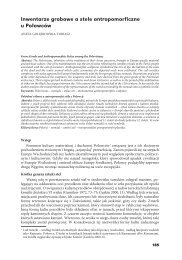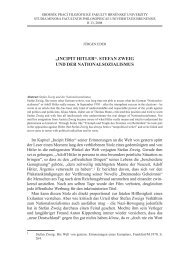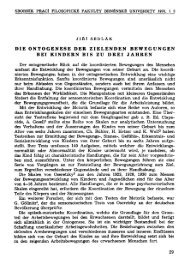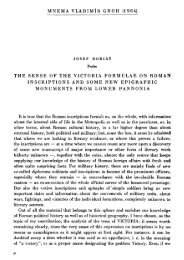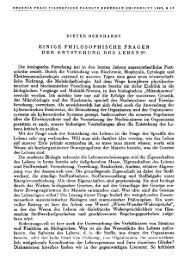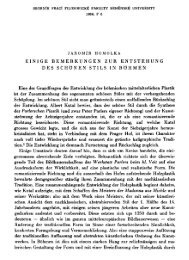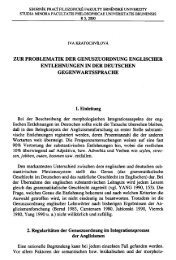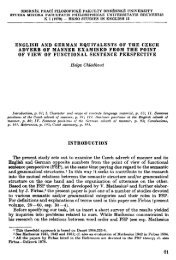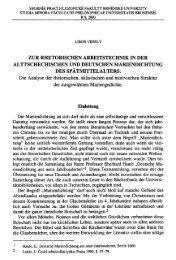publilius optatianus porfyrius: characteristic features of late ancient ...
publilius optatianus porfyrius: characteristic features of late ancient ...
publilius optatianus porfyrius: characteristic features of late ancient ...
You also want an ePaper? Increase the reach of your titles
YUMPU automatically turns print PDFs into web optimized ePapers that Google loves.
SBORNÍK PRACÍ FILOZOFICKÉ FAKULTY BRNĚNSKÉ UNIVERZITYSTUDIA MINORA FACULTATIS PHILOSOPHICAE UNIVERSITATIS BRUNENSISN 12, 2007MARIE OKÁČOVÁPublilius OPTATIANUS Porfyrius:Characteristic Features <strong>of</strong> Late AncientFigurative PoeticsThe genre <strong>of</strong> visual poetry with its typical literary-graphic nature has an ageold,widespread and strikingly colourful tradition including both European andAsian productions <strong>of</strong> sundry make-ups. The origins <strong>of</strong> the ‘effective symbiosis’<strong>of</strong> two otherwise distinct arts can be traced back to <strong>ancient</strong> Greece <strong>of</strong> the sixthand fifth century BC. The lyric poems composed in that period were to be sungto the accompaniment <strong>of</strong> a stringed instrument. Apart from music with poetry,the <strong>ancient</strong> Greeks were also most probably the first to explore the possible ways<strong>of</strong> ‘integrating’ poetry with visual arts. The earliest explicit reference to the relationbetween these two art forms was made by Simonides <strong>of</strong> Keos, a Greek lyricpoet <strong>of</strong> the sixth century BC, who claimed that poetry is a speaking picture andpainting a silent poetry. 1 The aural-pictorial amalgam exhibiting “an aestheticcorrelation between the textual and the graphic levels” whose interaction is basedon mimetic symbolism is then what Ernst 2 postu<strong>late</strong>d as the very essence <strong>of</strong> theworks referred to as technopaegnia or carmina figurata. Greek inscriptions datingback to the time <strong>of</strong> Simonides and imitative <strong>of</strong> the outer design <strong>of</strong> the artefactson which they are engraved, possibly together with the much older Phaistos disc,one <strong>of</strong> the most significant relics <strong>of</strong> the Minoan Bronze Age, with a remarkablysimilar arrangement <strong>of</strong> the graphic signs, can consequently be seen as somewhatcrude prototypes <strong>of</strong> the discussed class <strong>of</strong> poetry. 3The most ingenious ‘fully fledged’ visual poems – at least in the context <strong>of</strong>antiquity – were, however, composed only much <strong>late</strong>r by the Hellenistic and<strong>late</strong> Roman men <strong>of</strong> letters, who both elaborated and modified the primordial no-1 See Plut. De gloria Ath. III,346F. Cf. an analogous Latin comparison in Rhet. Her. IV,39:poema loquens pictura, pictura tacitum poema debet esse. All quotations <strong>of</strong> the original textsthat are available in electronic form were taken from .2 Er n s t 2002, 3. Cf. De o n n a 1926, 187.3 De n c k e r 1972, 8ff.
59Publilius OPTATIANUS Porfyrius: Characteristic Features <strong>of</strong> Late Ancient …an altar and a syrinx – can be recognized as the most direct ‘descendants’ notonly <strong>of</strong> the above-mentioned archaic epigraphs, but also <strong>of</strong> the Hellenistic patterncompositions that were inspiring for Optatian in terms <strong>of</strong> their form as wellas their content 11 (see Fig. 1). Nevertheless, the poet refined the formal design<strong>of</strong> the poems <strong>of</strong> his Greek precursors. Instead <strong>of</strong> the usual polymetry responsiblefor some imperfections in the graphic design <strong>of</strong> the Alexandrian poems, Optatianemployed the more challenging isometry which guarantees that graphicallyequivalent lines always have the same number <strong>of</strong> characters. The underlying principle<strong>of</strong> the examined poetry thus becomes arithmetic progression, i.e. the series<strong>of</strong> letters that increase or decrease by the same amount each time, forming metricallyconsistent lines that are the component parts <strong>of</strong> the intended figure.Further, the grid-poems, resembling crossword puzzles and sometimes aptlydesignated as carmina quadrata or carmina cancellata, represent Optatian’s ownbrainchild 12 and, in my view, by far the most sophisticated and spectacular type<strong>of</strong> his poetry. The fabric <strong>of</strong> these ‘verse mosaics’ consists in the interweavement<strong>of</strong> several textual planes whose intersections form the so-called versus intexti.The highlighted intext inserted into a quadrate – square or rectangular – gridframeis what makes these poems figured compositions. According to Ernst, thetwenty grid-pieces included in Optatian’s corpus can further be divided into threesubcategories in relation to the nature <strong>of</strong> their figurative patterns, i.e. poems withpredominantly geometrical configuration, verses with literal intexts composed<strong>of</strong> letters and Roman numerals, and pieces imitating real objects (see Fig. 3). 13Moreover, we shall particularize three bilingual – Graeco-Roman – grid-pieces,poem XVI and XXIII – both with geometrical patterns, and poem XIX – themasterpiece whose versus intexti portray an almost real-life ship with the Christianmonogram XP and letters VOT XX incorporated into its icon (see Fig. 3).The intertexture <strong>of</strong> the Latin base text and the Greek intext that can be found inthese three pieces does not exist in the works <strong>of</strong> either Optatian’s predecessorsor his followers. Without any loss <strong>of</strong> meaning or coherence, the poet intertwinedtwo seemingly disparate language systems, employing one and the same marksto stand for both Latin characters and visually similar or identical letters <strong>of</strong> theGreek alphabet with different phonemic values, though. The Latin A, for example,resembles and consequently becomes Greek alpha (A), delta (Δ) or lambda(Λ), Roman C turns into sigma (Σ), Roman X into chi (Σ), etc, etc.Generally speaking, the artistry involved in Optatian’s grid-poetry undoubtedlydeserves great respect on the part <strong>of</strong> the readership. With a bit <strong>of</strong> exaggeration,unlike the one-dimensional outline pieces the ‘crossword’ poems, based on11 It seems probable that Optatian used “the Ara <strong>of</strong> Dosiada as the model <strong>of</strong> his Ara, and theFistula <strong>of</strong> Theocritus for his Fistula” (He l m 1902, 43).12 Nevertheless, Optatian might have drawn some inspiration from the acrostic integrated intothe altar-shaped poem by the Alexandrian author Dosiadas (see Fig. 1) as well as from theacrostic poetry by Ennius and Commodianus (He l m 1902, 44).13 Er n s t 1991, 108–131.
61Publilius OPTATIANUS Porfyrius: Characteristic Features <strong>of</strong> Late Ancient …subtleties, 18 the piece also comprises several in essence grammatical subtletiessuch as the versus rhopalius 19 composed <strong>of</strong> a succession <strong>of</strong> one-, two-, three-,four- and five-syllable words and the teleion verse 20 in which all word classes exceptfor a numeral can be found. Moreover, in line 8, 21 both a metrical play and akind <strong>of</strong> wordplay can be detected. The verse in question is made up <strong>of</strong> a sequence<strong>of</strong> words – all in accusative – that retains its hexametric form whichever <strong>of</strong> theLatin cases is used. Further, concerning the application <strong>of</strong> the ars permutandi, themasterpiece is without doubt poem XXV. Polara’s edition <strong>of</strong> Optatian’s poetrylists twenty metrically homologous permutations <strong>of</strong> the original tetrastich. 22 AlthoughOptatian was neither the first nor the only one to apply the debated means<strong>of</strong> composing poetry, 23 the formal perfection and complexity <strong>of</strong> his productions,as demonstrated above, is unique. One more fact to be underlined at this point isthat Optatian’s ingenious metrical and language toys are products <strong>of</strong> particularmathematical rules by which they are also bound.Judged from the standpoint <strong>of</strong> its content and literary merit, Optatian’s poetry,providing the reader with not exceptionally innovative handling <strong>of</strong> various rathercommon topics, defies a clear-cut classification. One <strong>of</strong> the key motives onecan recognize in the examined collection is the laud <strong>of</strong> the emperor Constantinewhom the poet beseeches to call him back from exile where the monarch sent himunder obscure circumstances. 24 Further, the recurrent themes <strong>of</strong> Optatian’s verseincorporate religious subject matters, both pagan 25 and Christian, 26 frolicsome18 See, for example, Opt. Carm. XV,9: alme pater patriae, nobis te, maxime Caesar; the quotedline is a hexameter, read forward or backward. The following verse has four identical permutations<strong>of</strong> itself because <strong>of</strong> the metrical symmetry <strong>of</strong> its first four words (dactyl/molossus/molossus/dactyl)– Opt. Carm. XV,6: aurea Romanis propagans saecula nato.19 Opt. Carm. XV,5: quem divus genuit Constantius induperator.20 Opt. Carm. XV,7: heu nimis ad caelum properans, ni liquerit ille.21 Opt. Carm. XV,8: aeternum auxilium invictum iustumque piumque.22 In an exhaustive study <strong>of</strong> the discussed poem Flores and Polara calcu<strong>late</strong> the astonishingnumber <strong>of</strong> 784 possible permutations <strong>of</strong> the model stanza, i.e. 3136 lines (Fl o r e s – Po l a r a1969, 129). Cf. a more recent article on the same subject by Go n z á l e s i g l e s i a s 2000.23 In fact, Optatian’s metrical scheme – spondee/amphibrach/anapaest/amphibrach/spondeeor trochee – used in the reversible verses <strong>of</strong> his intextual poem XIII and <strong>late</strong>r adopted bySedulius Scottus, a poet <strong>of</strong> the ninth century AD, is a novel invention <strong>of</strong> his own (Dü c h t i n g1968, 26).24 Many scholars assume that the so-called Panegyricus Constantini, i.e. the cycle <strong>of</strong> eulogisticpoetry dedicated to the emperor Constantine on the occasion <strong>of</strong> his vicennalia, consists <strong>of</strong> thefirst twenty poems included in Optatian’s corpus, against which Polara convincingly argues;he emphasizes that there is no compelling evidence for the existence <strong>of</strong> the symbolic number<strong>of</strong> twenty panegyric poems addressed to the monarch and that the chronological order <strong>of</strong> thepoet’s pieces is also ambiguous (see Po l a r a 1975, 283).25 See Opt. Carm. VI, XVI, XX, XXVI, XXVII.26 See Opt. Carm. VIII, XIV, XIX, XXIV. Cf. an interesting article dealing with Optatian’s ideas<strong>of</strong> the Trinity as they are formu<strong>late</strong>d in his poem XXIV (Po l a r a 1983).
64 MARIE OKÁČOVÁIn consequence <strong>of</strong> the use <strong>of</strong> several ‘generative mechanisms’, namely the intextual,the reversible and the permutable verses, each poem can be read in severalways – that is, there is a number <strong>of</strong> possible configurations and transpositionsinherent in it. As Levitan points out, a mere line-count is typically much lowerthan the number <strong>of</strong> verses to be actually found in Optatian’s poetry. 39At this point, let us focus on the recipients <strong>of</strong> the examined thought-provokingcompositions. In order to ‘cope with’ the discussed works, readers have to becomeOptatian’s ‘partners’ in his poetics sui generis; they are supposed to activelyparticipate in the ‘reproduction’ <strong>of</strong> his poems. If they want to find a way out <strong>of</strong>the poet’s verse maze, they simply cannot be just passive consumers <strong>of</strong> literature,which was the case with the recipients <strong>of</strong> the majority <strong>of</strong> classical works; on thecontrary, their reading has to be productive or they will get lost in the labyrinth<strong>of</strong> the intersected lines. Readers’ active participation in Optatian’s ‘games’ withverses then presents them with an exceptional chance <strong>of</strong> glimpsing his workshopand his tools, i.e. they can see what precedes and underlies his ‘manufacturedproducts’. Further, this expository or even ‘exhibitionistic’ character <strong>of</strong> Optatian’spoems is remarkably consistent with their above-mentioned meta-poeticalcharacter that distinguishes the poet’s style from a literary perspective. Essentially,the author avails himself <strong>of</strong> every opportunity to draw readers’ attention tothe process <strong>of</strong> production <strong>of</strong> his formally exquisite poetry. By the way, Barthes, aFrench writer and critic, who applied the structuralist theory to literature, draws adistinction between the readerly (lisible) classic realist text which presents itselfas a literary creation to be consumed by the reader and the writerly (scriptible)text which displays its modes <strong>of</strong> production and whose reader becomes an activeproducer <strong>of</strong> meaning. 40 The former was the dominant literary form <strong>of</strong> thenineteenth century and the latter includes modern and post-modern works suchas those by Brecht. Keeping in mind Optatian’s preoccupation with the modes <strong>of</strong>production <strong>of</strong> his poetry and the great challenge his pieces constitute for the readers,we have to admit that his new poetics is recognizable as the writable ratherthan the readable text, and therefore can be understood as the precursor <strong>of</strong> theliterary output <strong>of</strong> the post-modern era. 41Furthermore, the analyzed collection can in several respects be seen as one<strong>of</strong> the most glaring examples <strong>of</strong> intertextuality in the broadest sense <strong>of</strong> this termassociated above all with structuralist and post-structuralist literary theory. First,the figurative composition <strong>of</strong> the grid-poems is founded on the intersections <strong>of</strong>individual lines, or rather, textual planes. The pieces in question are thus intertextualin the literal sense <strong>of</strong> the word. Second, not only does Optatian, as mentionedabove, handle rather commonplace themes in his lines, but he also uses a ratherderivative style. The poet’s phrasing simply echoes many <strong>of</strong> the classical models,including Ovid, Vergil and Horace as well as Catullus, Statius, Lucan and Colu-39 Le v i ta n 1985, 249.40 Ba rt h e s 1974, 4ff. Cf. Be l s e y 1988, 125–7.41 Cf. Go n z á l e z Ig l e s i a s 2000, 366.
65Publilius OPTATIANUS Porfyrius: Characteristic Features <strong>of</strong> Late Ancient …mella. One can consequently view his productions as intertextual ‘mosaics’ ormontages composed <strong>of</strong> miscellaneous elements, i.e. multiple allusions to variousgreat writers preceding him. Moreover, the poet’s metrical toys with their reversibleand permutable verses are intertextual in the sense that the numerous variants<strong>of</strong> each piece’s base text are essentially only potential dispositions <strong>of</strong> one and thesame component parts, namely the original word units. In general, the discussedpieces are combinations, re-combinations and permutations <strong>of</strong> Optatian’s ownverses that are, however, ‘amalgams’ <strong>of</strong> previous authors. This peculiarity <strong>of</strong> thepoet’s texts was examined especially by Gonzaléz Iglesias, who says that theverses are the embodiment <strong>of</strong> absolute intertextuality. 42Last but not least, I would like to draw attention to the fact that the generalplan <strong>of</strong> the collection can also be analyzed from the standpoint <strong>of</strong> structuralist andpost-structuralist theories <strong>of</strong> language. The poet’s work with the verse materialbasically betrays his notion <strong>of</strong> the atomistic structure and differential nature <strong>of</strong>language. Since these theories were introduced only much <strong>late</strong>r by F. de Saussureand C. S. Peirce, and afterwards developed especially by J. Lacan, Optatian’spieces must once again be seen as pioneering. This issue will, however, not bediscussed here any further because it has already been examined elsewhere. 43Having analyzed the corpus <strong>of</strong> Optatian’s poetry from several perspectives,we would like to emphasize its significance and interpret its message to futuregenerations. As a matter <strong>of</strong> fact, the discussed works constitute an integral part<strong>of</strong> the tradition <strong>of</strong> figured poetry, or rather, the culmination <strong>of</strong> its developmentin antiquity. Despite the fact that Optatian drew inspiration from his Greek aswell as Latin predecessors, his collection makes interesting, highly original andchallenging ‘reading’. The author’s contribution to the genre <strong>of</strong> visual poetryconsists especially in the extraordinary formal precision and refinement <strong>of</strong> hisplayful pieces, most <strong>of</strong> which capture one’s attention primarily as visual and notliterary works <strong>of</strong> art. Optatian’s formal innovations include the introduction <strong>of</strong>isometrical outline poems, the technique <strong>of</strong> versus intexti and last but not least,the artistry known as ars permutandi in which Optatian approached absolute perfection.The last two <strong>of</strong> the above-listed sophisticated devices, together with theso-called versus cancrini, improve the quality and increase the quantity <strong>of</strong> the poet’sverses. Contrariwise, as far as Optatian’s literary style is concerned, the poetborrowed heavily from many great classical authors, which makes his writings anembodiment <strong>of</strong> intertextuality. Nevertheless, the author’s recurring meta-poeti-42 Go n z á l e z Ig l e s i a s 2000, 345, 355, 364–6. The same scholar also lends support to the abovepresentedtheory about the ‘exhibitionistic’ nature <strong>of</strong> Optatian’s poetry: “La imitatio, la interpretatio,la aemulatio, (procedimientos básicos en la poética clásica) se ejercen secundariamentesobre otros autores, porque ante todo las ejerce el texto sobre sí mismo, sobre suspropias palabras: cada estr<strong>of</strong>a sobre la anterior, y todas sobre la estr<strong>of</strong>a cero. Una especie deautoerotismo masturbatorio ejemplifica la fecundidad plena del ejercicio literario (tan propiode la época). Referirse a sí mismo es la única alternativa para el gran admirador de Virgilioque es Optaciano Porfirio, .... ” (Go n z á l e z Ig l e s i a s 2000, 362).43 See Ok á č o v á 2006.
67Publilius OPTATIANUS Porfyrius: Characteristic Features <strong>of</strong> Late Ancient …RESUMÉCílem předkládaného článku je představit a blíže charakterizovat jedinečnou sbírku figurálnípoezie relativně málo známého pozdně antického autora Publilia Optatiana Porfyria. Po stručnémnástinu vlastních počátků a ideové koncepce vizuálního básnictví jako takového následuje formálnía obsahová analýza, resp. klasifikace dotyčného souboru skladeb, jejímž cílem je stanovit mírunávaznosti Optatianova díla na předchozí řeckou i římskou tradici a zhodnotit jeho přínos danémuliterárnímu žánru. Nalezené význačné rysy zkoumaného veršového korpusu přitom poukazujízejména na jeho novátorskou a neobvykle s<strong>of</strong>istikovanou formální koncepci. Z hlediska obsahua literárního stylu představují pak unikum sbírky především autorovy občasné teoreticky laděnékomentáře, jimiž objasňuje důmyslnou kompozici některých svých skladeb, což nám jen potvrzuje,že to byla právě forma, která v rámci básníkových uměleckých aspirací zaujímala primární postavení.Při rozboru Optatianových skladeb je dále věnována jistá pozornost také jejich čtenáři, resp.nárokům, jež na něj básník svými rafinovanými hříčkami klade. Daná tvorba, které se v článku podvlivem moderních literárních teorií dostává označení intertextuální meta-poetika a jež se ve svépodstatě zakládá na ryze matematických principech, je nakonec vyhodnocena jako poezie vysoceoriginální a nadčasová.Marie OkáčováÚstav klasických studií FF MU(52294@mail.muni.cz)
68 MARIE OKÁČOVÁAppendix: Figured Poetry <strong>of</strong> Publilius OPTATINUS Porfyrius and the Greek Models.Figure 1:Simias: The Wings.Simias: The Egg.Simias: The Axe.Theocritus: The Syrinx.
69Publilius OPTATIANUS Porfyrius: Characteristic Features <strong>of</strong> Late Ancient …Dosiadas: The Iason Altar.Besantinos: The Muse Altar.Figure 2:Optatianus Porfyrius: outline poem in the form<strong>of</strong> an altar (Carmen XXVI).Optatianus Porfyrius: outline poem in the shape<strong>of</strong> an organ (Carmen XX).Optatianus Porfyrius: outline poem arranged asa syrinx (Carmen XXVII).
70 MARIE OKÁČOVÁFigure 3:Optatianus Porfyrius: grid-poem with a geometricalpattern (Carmen III).Optatianus Porfyrius: grid-poem with a literalintext (Carmen V).Optatianus Porfyrius: grid-poem whose versusintexti form the figure <strong>of</strong> a palm (Carmen IX).
71Publilius OPTATIANUS Porfyrius: Characteristic Features <strong>of</strong> Late Ancient …Greek and Latin intext:Optatianus Porfyrius: bilingual intextual poem in the shape <strong>of</strong> an oared vessel (Carmen XIX).


